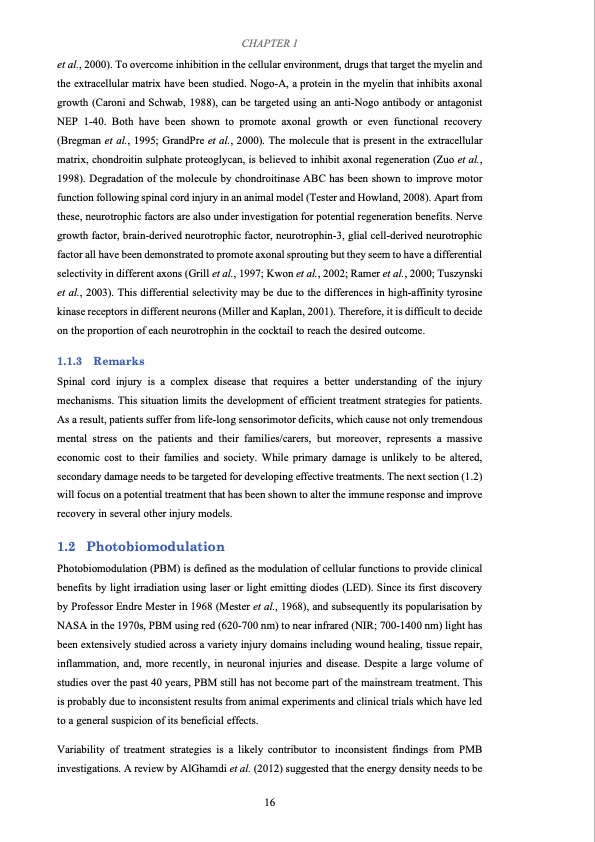
PDF Publication Title:
Text from PDF Page: 030
CHAPTER 1 et al., 2000). To overcome inhibition in the cellular environment, drugs that target the myelin and the extracellular matrix have been studied. Nogo-A, a protein in the myelin that inhibits axonal growth (Caroni and Schwab, 1988), can be targeted using an anti-Nogo antibody or antagonist NEP 1-40. Both have been shown to promote axonal growth or even functional recovery (Bregman et al., 1995; GrandPre et al., 2000). The molecule that is present in the extracellular matrix, chondroitin sulphate proteoglycan, is believed to inhibit axonal regeneration (Zuo et al., 1998). Degradation of the molecule by chondroitinase ABC has been shown to improve motor function following spinal cord injury in an animal model (Tester and Howland, 2008). Apart from these, neurotrophic factors are also under investigation for potential regeneration benefits. Nerve growth factor, brain-derived neurotrophic factor, neurotrophin-3, glial cell-derived neurotrophic factor all have been demonstrated to promote axonal sprouting but they seem to have a differential selectivity in different axons (Grill et al., 1997; Kwon et al., 2002; Ramer et al., 2000; Tuszynski et al., 2003). This differential selectivity may be due to the differences in high-affinity tyrosine kinase receptors in different neurons (Miller and Kaplan, 2001). Therefore, it is difficult to decide on the proportion of each neurotrophin in the cocktail to reach the desired outcome. 1.1.3 Remarks Spinal cord injury is a complex disease that requires a better understanding of the injury mechanisms. This situation limits the development of efficient treatment strategies for patients. As a result, patients suffer from life-long sensorimotor deficits, which cause not only tremendous mental stress on the patients and their families/carers, but moreover, represents a massive economic cost to their families and society. While primary damage is unlikely to be altered, secondary damage needs to be targeted for developing effective treatments. The next section (1.2) will focus on a potential treatment that has been shown to alter the immune response and improve recovery in several other injury models. 1.2 Photobiomodulation Photobiomodulation (PBM) is defined as the modulation of cellular functions to provide clinical benefits by light irradiation using laser or light emitting diodes (LED). Since its first discovery by Professor Endre Mester in 1968 (Mester et al., 1968), and subsequently its popularisation by NASA in the 1970s, PBM using red (620-700 nm) to near infrared (NIR; 700-1400 nm) light has been extensively studied across a variety injury domains including wound healing, tissue repair, inflammation, and, more recently, in neuronal injuries and disease. Despite a large volume of studies over the past 40 years, PBM still has not become part of the mainstream treatment. This is probably due to inconsistent results from animal experiments and clinical trials which have led to a general suspicion of its beneficial effects. Variability of treatment strategies is a likely contributor to inconsistent findings from PMB investigations. A review by AlGhamdi et al. (2012) suggested that the energy density needs to be 16PDF Image | Effects of Red Light Treatment on Spinal Cord Injury

PDF Search Title:
Effects of Red Light Treatment on Spinal Cord InjuryOriginal File Name Searched:
Thesis_Di Hu_final.pdfDIY PDF Search: Google It | Yahoo | Bing
Cruise Ship Reviews | Luxury Resort | Jet | Yacht | and Travel Tech More Info
Cruising Review Topics and Articles More Info
Software based on Filemaker for the travel industry More Info
The Burgenstock Resort: Reviews on CruisingReview website... More Info
Resort Reviews: World Class resorts... More Info
The Riffelalp Resort: Reviews on CruisingReview website... More Info
| CONTACT TEL: 608-238-6001 Email: greg@cruisingreview.com | RSS | AMP |